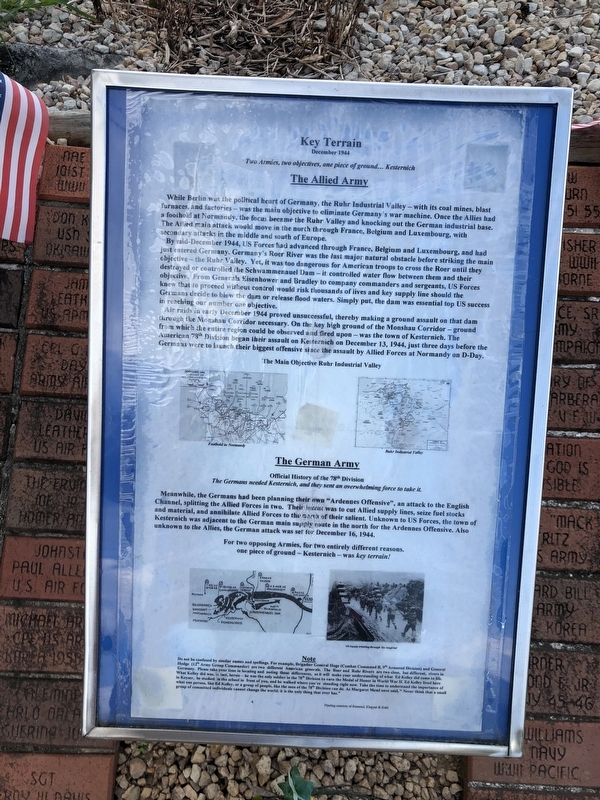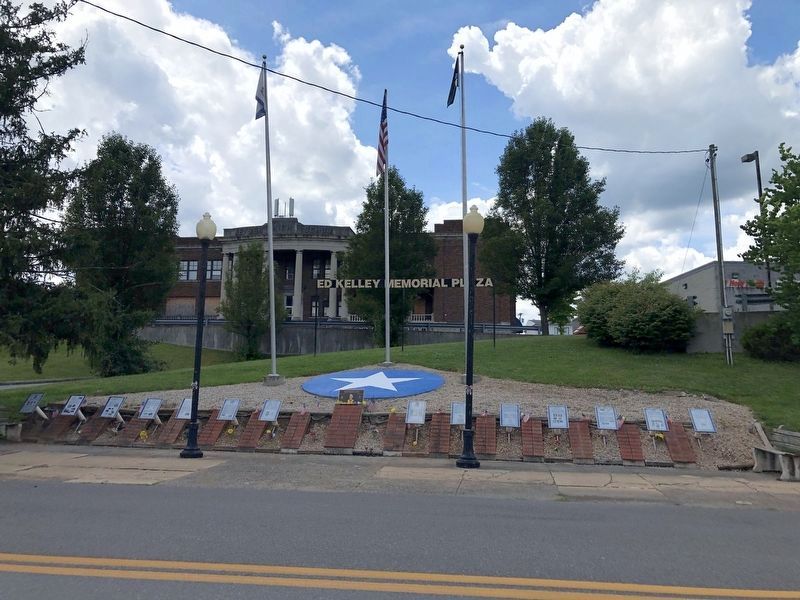Keyser in Mineral County, West Virginia — The American South (Appalachia)
Key Terrain
December 1944
Two Armies, two objectives, one piece of ground... Kesternich
While Berlin was the political heart of Germany, the Ruhr Industrial Valley — with its coal mines, blast furnaces, and factories — was the main objective to eliminate Germany's war machine. Once the Allies had a foothold at Normandy, the focus became the Ruhr Valley and knocking out the German industrial base. The Allied main attack would move in the north through France, Belgium and Luxembourg, with secondary attacks in the middle and south of Europe.
Air raids in early December 1944 proved unsuccessful, thereby making a ground assault on that dam through the Monshau Corridor necessary. On the key high ground of the Monshau Corridor — ground from which the entire region could be observed and fired upon — was the town of Kesternich. The American 78th Division began their assault on Kesternich on December 13, 1944, just three days before the Germans were to launch their biggest offensive since the assault by Allied Forces at Normandy on D-Day.
Official History of the 78th Division
The Germans needed Kesternich, and they sent an overwhelming force to take it.
Meanwhile, the Germans had been planning their own "Ardenne Offensive", an attack to the English Channel, splitting the Allied Forces in two. Their intent was to cut Allied supply lines, seize fuel stocks and material, and annihilate Allied Forces to the north of their salient. Unknown to US Forces, the town of Kesternich was adjacent to the German main supply route in the north for the Ardennes Offensive. Also unknown to the Allies, the German attack was set for December 16, 1944.
For two opposing Armies, for two entirely different reasons. one piece of ground — Kesternich — was key terrain!
Note Do not be confused by similar names and spellings. For example, Brigadier General Hoge (Combat Command B, 9th Armored Division) and General Hodge (12th Army Group Commander) are two different American generals. The Roer and Ruhr Rivers are two close, but different, rivers in Germany. Please take your time in locating and noting these differences, as it will make your understanding of what Ed Kelley did come to life. What Kelley did was, in fact, heroic — he was the only soldier in the 78th Division to earn the Medal of Honor in World War II. Ed Kelley lived here in Keyser, he studied in the school in front of you, and he walked where you're standing right now. Take the time to understand the importance of what one person, like Ed Kelley, or a group of people, like the men of the 78th Division can do. As Margaret Mead once said, "Never think that a small group of committed individuals cannot change the world; it is the only thing that ever has."
Topics and series. This historical marker is listed in these topic lists: Natural Resources • War, World II • Waterways & Vessels. In addition, it is included in the Former U.S. Presidents: #34 Dwight D. Eisenhower, and the Medal of Honor Recipients series lists. A significant historical month for this entry is December 1944.
Location. 39° 26.382′ N, 78° 58.615′ W. Marker is in Keyser, West Virginia, in Mineral County. Marker is on West Piedmont Street (West Virginia Route 46) just west of North Davis Street, on the left when traveling west. Touch for map. Marker is at or near this postal address: 32 N Davis St, Keyser WV 26726, United States of America. Touch for directions.
Other nearby markers. At least 8 other markers are within walking distance of this marker. The First Battle of Kesternich (here, next to this marker); The Battle of the Bulge (here, next to this marker); D-Day (here, next to this marker); World War II (here, next to this marker); Regaining the Initiative (here, next to this marker); Kelley Memorial Plaza (here, next to this marker); Jonah Edward Kelley (here, next to this marker); The Medal of Honor (here, next to this marker). Touch for a list and map of all markers in Keyser.
Credits. This page was last revised on July 20, 2020. It was originally submitted on July 14, 2020, by Devry Becker Jones of Washington, District of Columbia. This page has been viewed 103 times since then and 16 times this year. Photos: 1. submitted on July 14, 2020, by Devry Becker Jones of Washington, District of Columbia. 2. submitted on July 14, 2020.

